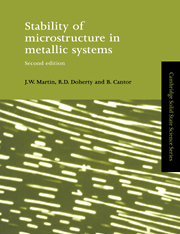Book contents
- Frontmatter
- Contents
- Preface to first edition
- Preface to second edition
- Chapter 1 The general problem of the stability of microstructure
- Chapter 2 Structural instability due to chemical free energy
- Chapter 3 Highly metastable alloys
- Chapter 4 Instability due to strain energy
- Chapter 5 Microstructural instability due to interfaces
- Chapter 6 Other causes of microstructural instability
- References
- Index
Chapter 6 - Other causes of microstructural instability
Published online by Cambridge University Press: 18 December 2009
- Frontmatter
- Contents
- Preface to first edition
- Preface to second edition
- Chapter 1 The general problem of the stability of microstructure
- Chapter 2 Structural instability due to chemical free energy
- Chapter 3 Highly metastable alloys
- Chapter 4 Instability due to strain energy
- Chapter 5 Microstructural instability due to interfaces
- Chapter 6 Other causes of microstructural instability
- References
- Index
Summary
Introduction
The earlier chapters of this book have dealt with the major causes of instability in the microstructure of metals and alloys, but there remains a series of other influences which can also modify the structure. Plastic deformation and irradiation can totally alter the defect structure in metal crystals, and corrosion can completely destroy not only the metallic microstructure but the metal itself. These subjects are, however, too extensive in scope and too important to materials science to be dealt with in a brief chapter. In addition they do not fall within a reasonable definition of the stability of microstructure. However, there have been some interesting and important investigations of the stability of dispersed second-phase precipitates under conditions of plastic deformation, and to a smaller extent, of their stability under irradiation. These instabilities will be discussed here. Other types of external influences include: temperature gradients; gravitational, electrical and magnetic fields; and, finally, annealing under imposed elastic stresses. All of these influences have been found to cause changes in precipitate morphology, and will form the subject of this chapter.
Many of the most informative experiments in this area have been carried out on transparent non-metallic materials such as ice and potassium chloride. The results of these investigations appear to be of direct application to metals and so, for the purposes of this chapter, any material subjected to a relevant and interesting experiment will be considered metallic.
- Type
- Chapter
- Information
- Stability of Microstructure in Metallic Systems , pp. 367 - 402Publisher: Cambridge University PressPrint publication year: 1997



